Optical microscopy and spectroscopy
LAMBS offers TNA access for:
- Nikon confocal microscope. (ALMF-IIT) A1R Resonant Confocal System on TiE Inverted Microscope.
- Nikon confocal and multiphoton resonant scanner microscope, with ISS fast-FLIM module. (ALMF-IIT)
- A1r MP Multiphoton Confocal System on TiE Inverted Microscope with Okolab incubation system and FLIM capability.
- Nikon super resolution system. N-STORM Super-Resolution System on TiE Inverted Microscope and Andor camera iXon 897.
- Nikon super resolution system. N-SIM Super-Resolution System on TiE Inverted Microscope with cage incubator system and Andor camera iXon 897.
- Olympus Confocal inverted microscope. FV1000 Confocal microscope.
- Leica Stellaris 8 STED.
- Leica Spectral confocal, multiphoton and STED inverted microscope. Leica TCS STED-CW gated and super-continuum excitation.
- Genoa Instruments PRISM, image scanning microscopy and fluorescence lifetime super-resolution system.
- Custom adapted FLIM and MP-STED CW microscope. On Leica TCS STED-CW gated:
- Custom made IML-SPIM microscope.
Sample requirements
- You may need specific cell lines to observe cell-specific effects. Users should contact and discuss in advance about cell lines, culturing medium, and any other chemical compounds that can be necessary or that can influence the acquisition of the fluorescence signal.
- Specific stable cell lines expressing the protein of interest can also be generated and analyzed.
- Living cell staining can be realized by genetically encoded fluorescent proteins or tags. Synthetic dyes and monoclonal antibodies can also be used. For fixed cells, fluorescence immuno-staining can be performed. In any case, it could be essential to discuss which dyes can be the best suited for the application and the elected microscopy method.
Other relevant considerations
- The attachment of an appropriate fluorescent molecule is essential for the success of the experiments.
- Each super-resolution method could have different requirements, and some fluorophores are better suited than others.
- For immunocytochemistry, specific antibodies are required, and they should be verified for the specific cell line of interest.
- Fluorescently labelled ligands can also be used.
For specific details on the experimental protocol, please contact the lab. Contact person: Paolo Bianchini ()
AFM-STED, AFM-STORM correlative microscopes
LAMBS offers TNA access for:
- Bruker Nanowizard II AFM on a STED Leica TCS STED-CW gated (optimized for green fluorescence)
- Bruker Nanowizard II AFM on a N-STORM Super-Resolution System on TiE Inverted Microscope and Andor camera iXon 897.
- Bruker Nanowizard IV AFM on a STED Leica Stellaris 8 (optimized for red fluorescence.
Samples requirements
The requirements applied to super-resolution optical microscopy are also extended to the sample for correlative microscopy.
Furthermore:
- suitable sample for AFM must be pure, better if crystallography grade. The AFM is a label-free technique and can detect the morphological features of the sample and of any contaminants if present.
- The substrate must be a standard glass coverslip (not mica, graphite, etc.).
- The AFM needs a minimal amount of samples. Generally, all the samples prepared for super-resolution microscopy have enough material for the AFM inspection.
In general, the preparation of the samples for correlative microscopy must be carefully designed and must be discussed with the facility team.
Contact person: Claudio Canale ()
